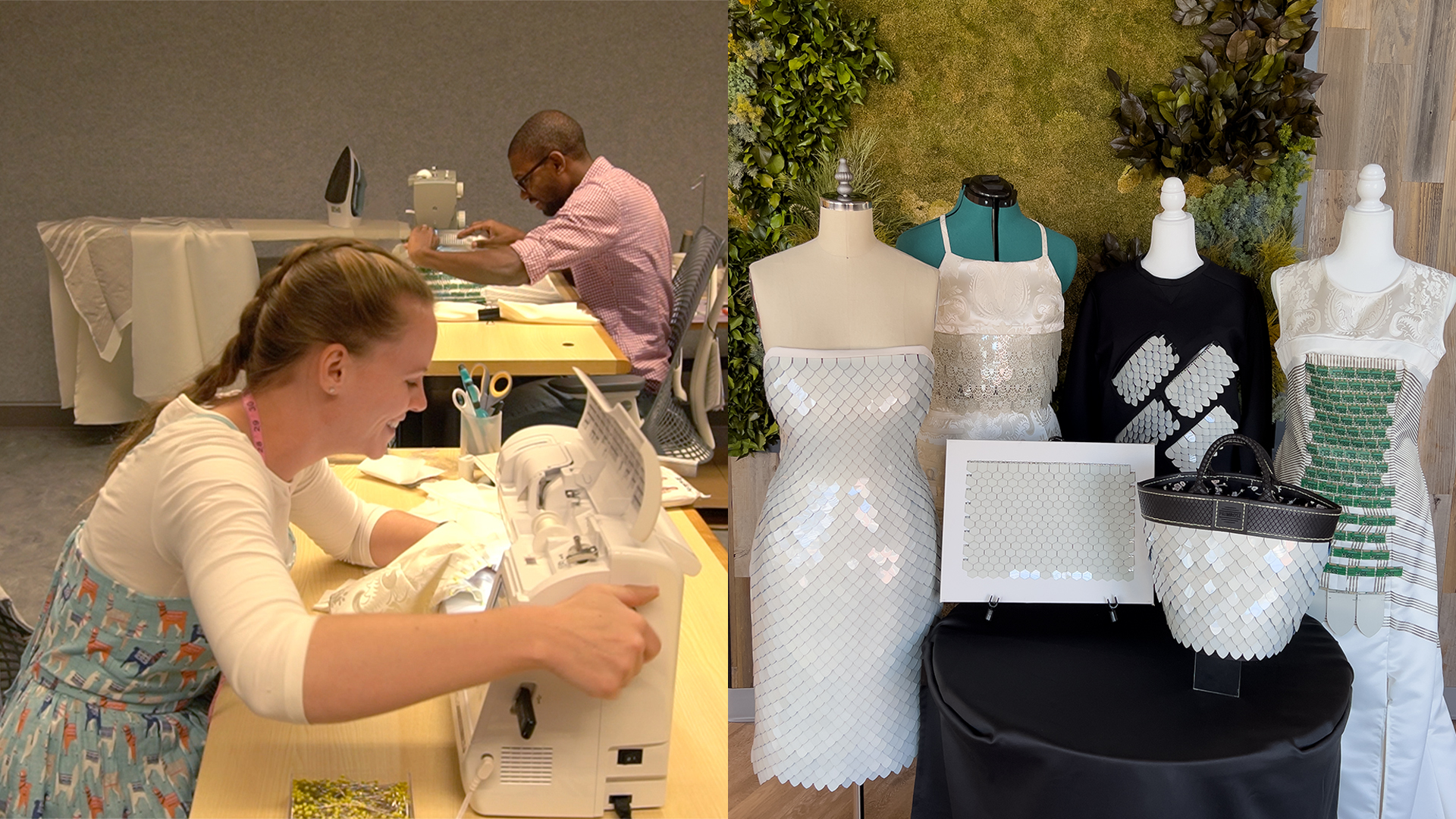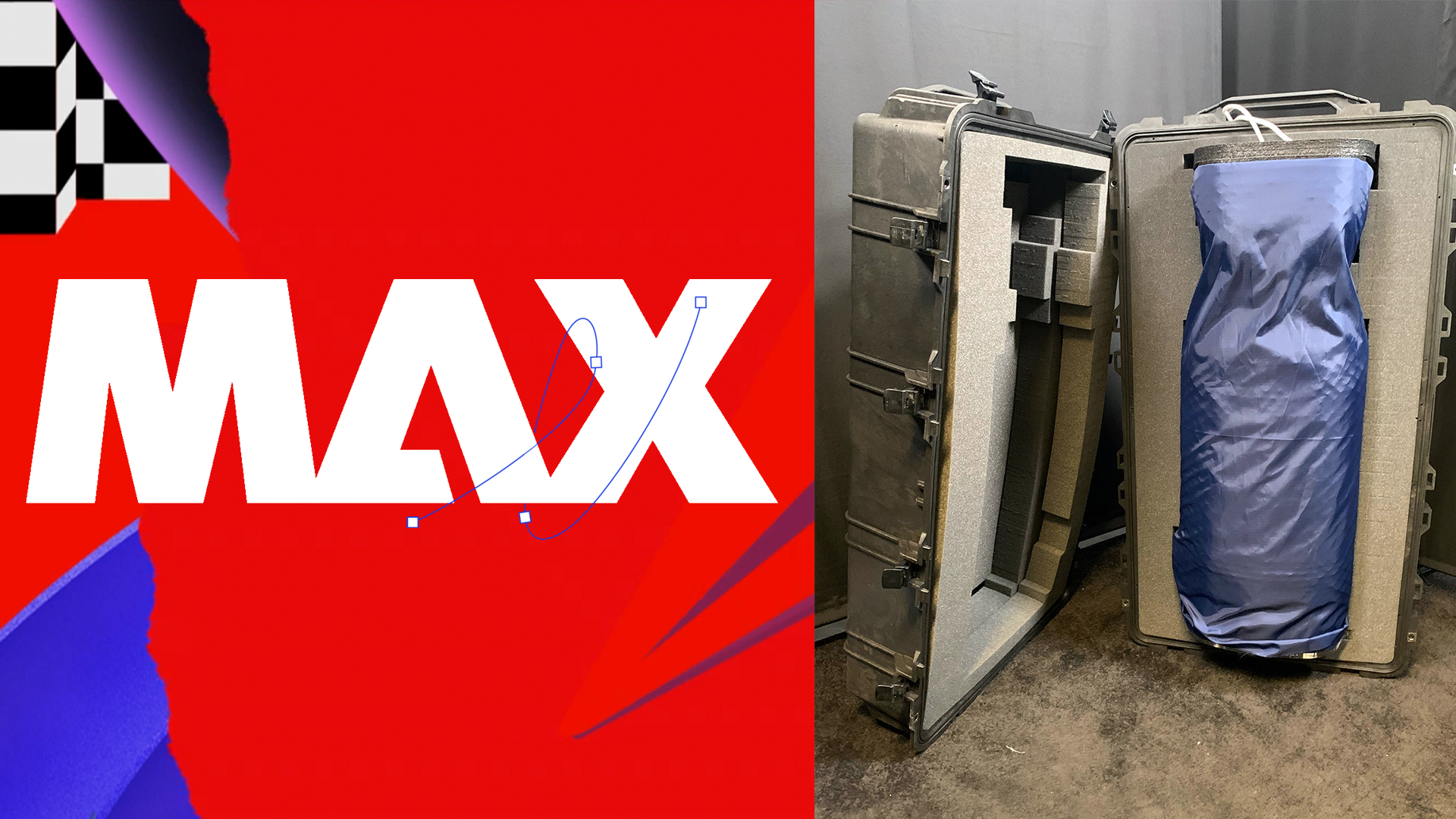It began as a grand challenge—to invent a new kind of canvas for creativity. It became a magical dress made of 1,182 sequin-like petals, sewn by hand onto a fairy-tale garment for the digital age. The digital dress, better known as Project Primrose, came alive with shifting patterns and flows at last year’s Adobe MAX, and the audience fell in love.
After its MAX debut, Primrose went to MAX Japan, New York City, and Spain with Sofía Vergara — and it went viral. So far, millions of people have shared and commented on the dress that heralds a future of wearable, instantly changeable textiles.
How the Primrose idea came to be
Way back in 2013, the Adobe Research team created a video packed with big ideas, The Vision of the Future. It included a sweater that could change its appearance with the weather—a mashup of hardware and software that you could actually wear, and design and re-design endlessly.
“The sweater was a metaphor for an imaginative future. And it was such a compelling idea that we wanted to figure out how it could be done in real life,” explains Gavin Miller, Head of Adobe Research and one of the Primrose inventors.
When Research Scientist and Engineer TJ Rhodes joined Adobe Research to help launch the group’s hardware prototyping team in 2017, he and Miller began collaborating on Project Glasswing. Glasswing is a translucent box with a display that shows animated designs, such as sloshing water, in front of an object inside. With one hardware project under their belts, they decided to use their discoveries from Glasswing to create a garment.
Miller and Rhodes knew they’d face challenges developing electronics suitable for clothing—the dress would need to be lightweight, flexible, durable, and safe against the skin. And, of course, they knew it would be unusual to launch a hardware-centric project at a software-focused company.
“Even though a significant amount of Project Primrose falls into the hardware category, we had the same mission as the rest of Adobe: to create personalized digital experiences,” explains Rhodes. “We considered Primrose a canvas for creative ideas, and we knew that it would eventually become a software project. You need the creative software element to bring the dress to life.”
Building the team—and the hardware—for Primrose
Making Project Primrose required a unique blend of expertise. Rhodes, who’s adept at rapid prototyping, was critical as the team created the petals (the dress’s dynamic pixels), electronics, and controller for the garment. “This is what our Emerging Devices Group (EDG) does—we’re hyper-resourceful,” explains Rhodes, “And we have a knack for finding beauty and utility in the scraps and the stuff that others were going to throw away.”
Miller’s robotics hobby provided critical background knowledge for the team. “The circuitry for Primrose is like a giant version of the circuits I use for robots. We had to use special smart-window materials and design the logic of the switches on a chip that was thin, flexible, and robust enough to work,” says Miller. When he began to think about making a dress, he had an “aha moment” when he placed a piece of tracing paper onto a mirror, and saw it go from translucent to matte white. If that paper could be replaced by a switchable diffuser, the color could transform from silver to white, “both subtle and luxurious,” he says.
The team also needed an expert on wearables and textiles—who could sew. So, they reached out to Christine Dierk, a UC Berkeley graduate student with interdisciplinary expertise in hardware prototyping, design, and traditional craft practices. In her PhD research, Dierk was already designing and developing novel wearable technologies, and the work had inspired her to hone her needlework skills in her spare time.
Dierk joined the team as a summer intern, and by fall they had an early prototype of the dress. But there was still a lot more they wanted to accomplish. “That last ten percent is usually way harder than the first 90 percent,” says Rhodes. They brought Dierk back as a full-time Research Scientist in 2020, and together they devised a longer-term plan with incremental milestones and more prototypes along the way.
The next step was to create a 2D canvas to test the circuitry without worrying about the bending and flexing you have to account for in a garment. Then they developed a handbag, a more complicated prototype that integrated curved surfaces. Finally, the team returned to the dress, tackling curves, bends, flexible fabric, and more movement.

Designing and crafting the Primrose dress
Using Adobe Illustrator, the team designed a pattern that would accommodate the dress’s complicated electronics. But by the time they were ready to assemble it, everyone was working from home for Covid. As Dierk recalls, “That’s how I ended up being the one to wear the dress. It would have been hard to do fittings in person, so I thought, okay, I’ll make it my size so the model will always be available.”
Constructing the dress was a complicated mix of experimentation, electrical engineering, and textile work, including hand-sewing in 74 driver boards to run the petals and attaching each of the 1,182 petals by hand in the exact right places.
“The petals were a geometry problem. To accommodate the shape of the dress, we needed to use wider petals in places where the dress is wider and narrower petals in the narrow places. We had 16 different sizes to keep everything looking uniform,” explains Dierk. “Then we created a petal-by-petal map in Illustrator. Attaching them was like a paint-by-number project.”
The team also developed a software pipeline so they could use Adobe After Effects and Illustrator to create patterns and flows for the petals, and then translate them into code for the dress. After years of whiteboarding, prototyping, and handcrafting, the dress that started as a vision for the future was finally real.
Miller, Rhodes, and Dierk kept the project secret until 2022, when they finally unveiled the technology behind the canvas and handbag prototypes in a paper at the ACM Symposium on User Interface Software and Technology (UIST). After UIST, the next stop was MAX.
The big MAX reveal
When Dierk walked onto the MAX stage in the Project Primrose dress, it was unlike anything she’d experienced before. “That’s definitely the most people I’ve ever spoken to at one time—but the audience was amazing. Everyone was cheering and clapping and that helped a lot because I knew everyone was on my team.” After MAX, Primrose was a hit all over again in the press and on social media. “I knew people would like it, but I never imagined the scale of the response,” says Dierk. “It’s cool to see people covering the work, but it’s a little weird to see my face on People magazine and Reddit, or when I’m scrolling TikTok.”

Project Primrose’s inventors envision a big future
“We wanted to inspire the world—to show that this is something that’s technically possible,” says Miller. “Ultimately, this could open new paths for creativity. Project Primrose is like visual music for storytelling.”
Dierk adds, “I hope the big takeaway is that fashion doesn’t have to be static—it can be dynamic and interactive. I hope it inspires people in technology and fashion design, and anyone who does making.” “When I first saw Primrose lighting up during the pandemic, I knew this was going to be a game changer,” says Rhodes. “It could become an art installation. It could cover the walls in your home, or become a giant, animated backdrop in a store. I also want to see Primrose make it all the way to the red carpet—you don’t have to choose one future for Primrose.”
Additional contributors to Project Primrose from Adobe Research include Daichi Ito, Oscar Dadfar, Tim Ganter, and Giorgio Gori.
Wondering what else is happening inside Adobe Research? Check out our latest news here.